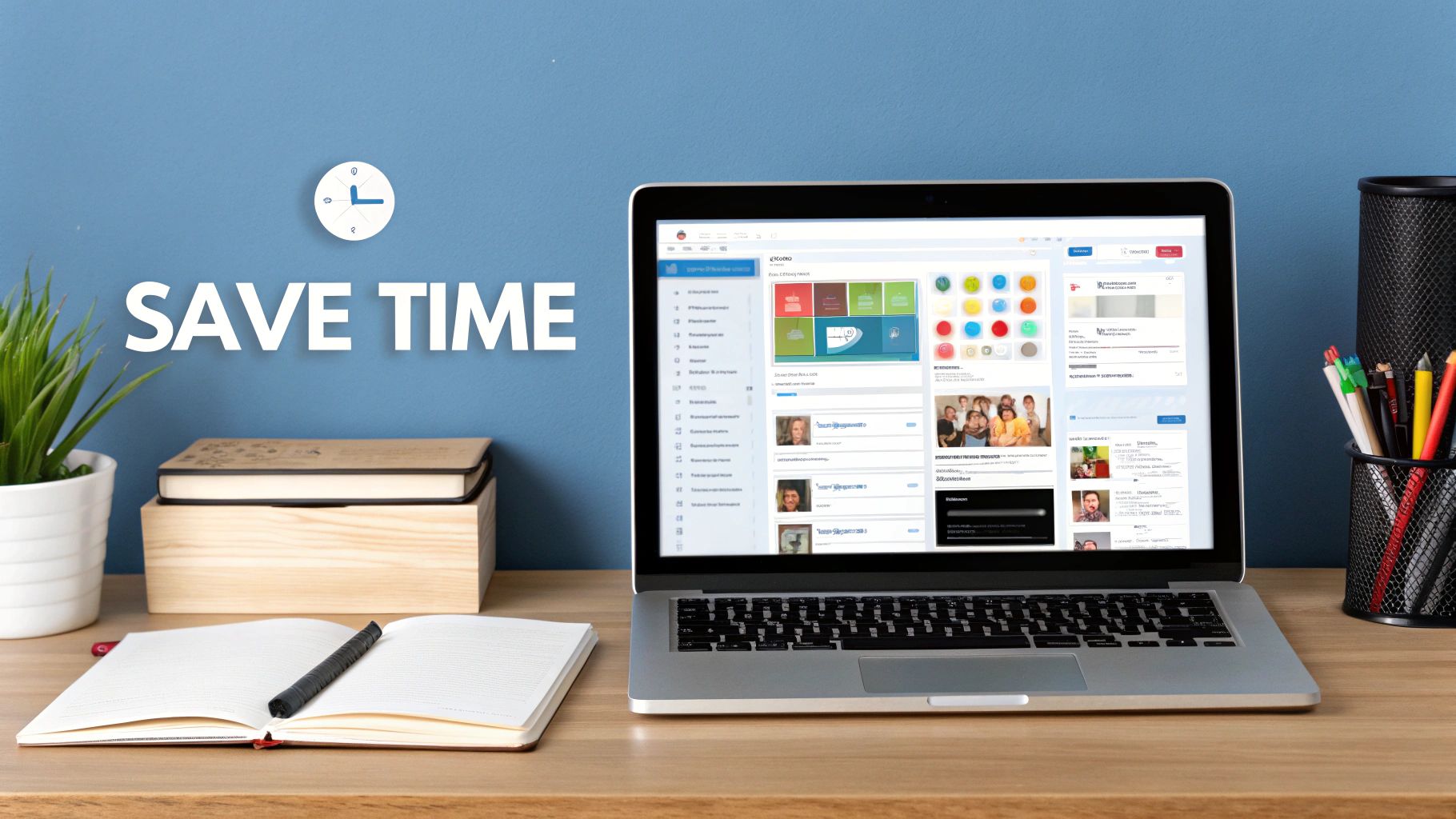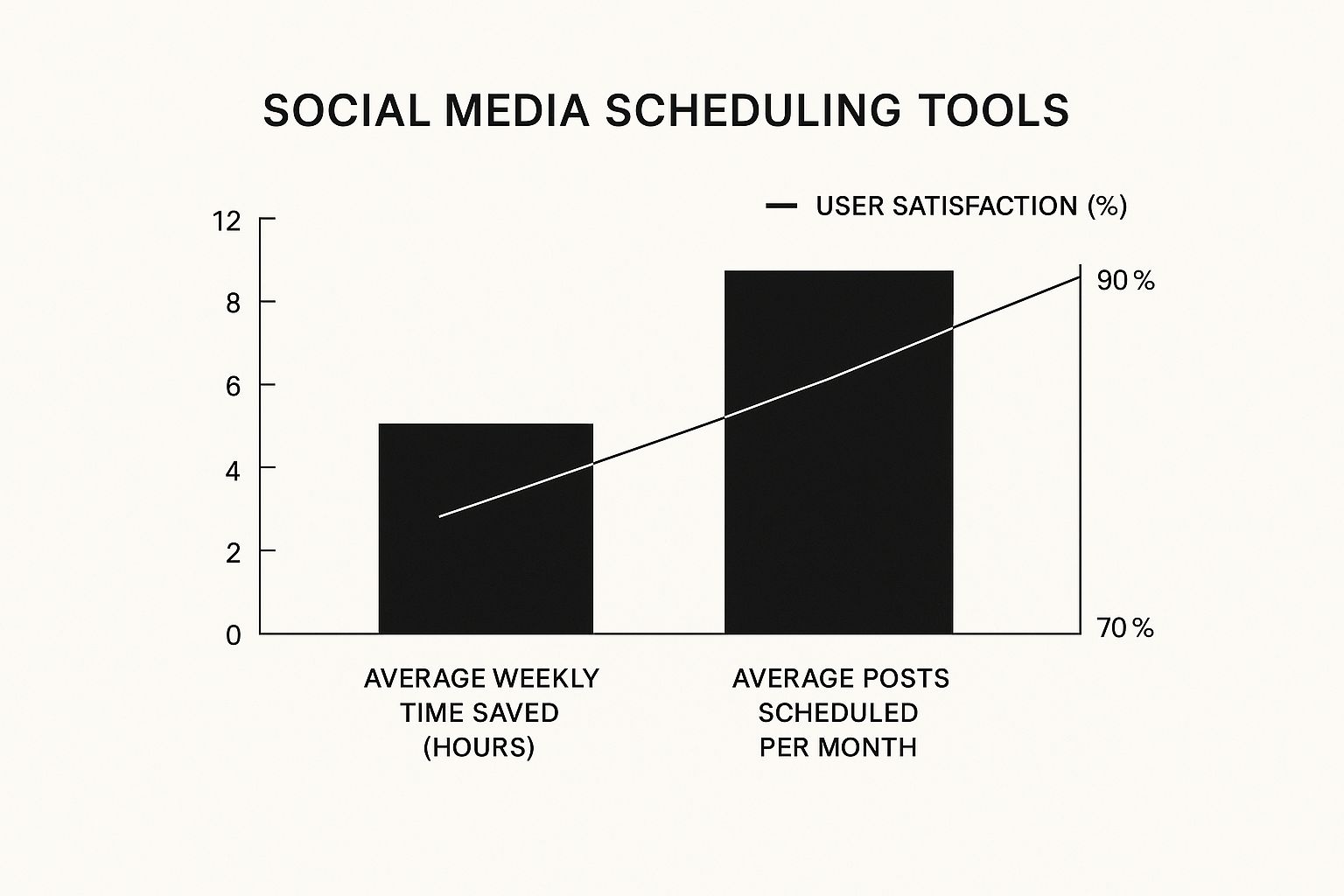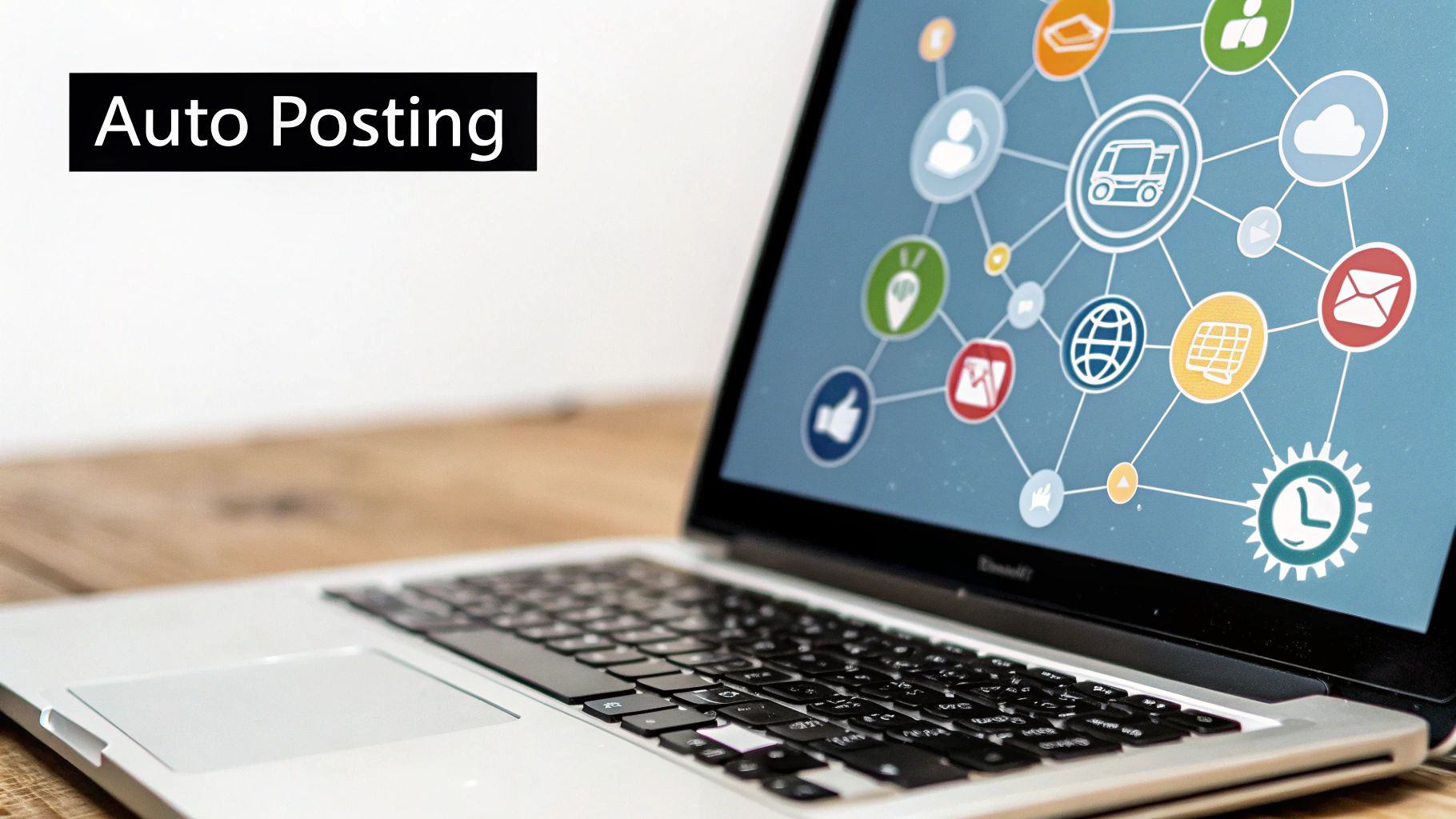Why Strategic Post Scheduling Transforms Social Results

Manually posting on social media can be a drain on your productivity. Strategic post scheduling offers a powerful alternative, freeing up your time and boosting your results. This isn't just about saving time; it’s about a fundamental shift in your social media approach.
Consistent Presence and Reduced Burnout
Maintaining a consistent online presence is key for social media success. Think of your social media feeds as virtual storefronts. Regular updates keep your audience engaged, while inactivity can signal neglect. Scheduling ensures consistent updates, even when you’re busy with other tasks. This also reduces team burnout from the pressure of constant, real-time posting.
Strategic Engagement and Optimal Timing
Scheduling empowers you to target specific times when your audience is most active. This increases visibility and engagement. Understanding optimal timing is crucial, especially when managing multiple platforms. Research suggests the best times to post are generally between Mondays and Thursdays, from 10 a.m. to 1 p.m.
However, this varies by platform. Facebook and Instagram see high engagement in the mornings. LinkedIn is most active during midday. TikTok performs well from noon to early evening. Aligning your posting strategy with these peak periods can maximize your reach.
Tools like Sprout Social's Optimal Send Times and ViralPost use AI to analyze audience engagement and personalize posting schedules. Learn more about optimizing your posting schedule: Find more detailed statistics here.
Authenticity and Spontaneity
Some worry that scheduled posts feel inauthentic. However, modern scheduling tools like EvergreenFeed allow for a balance between planned content and spontaneous updates. Think of it like meal prepping: You plan the main course, but you can always add fresh touches later.
Scheduling provides the structure, while real-time interactions maintain authenticity. You can still respond to trending topics and engage in conversations while keeping your core content strategy on track. Brands using strategic scheduling have reported engagement increases of 40%+. This demonstrates how structured spontaneity can significantly boost your social media success.
Platform-Specific Timing: When Your Audience Is Actually Listening
The idea of one ideal time to post on social media is a myth. General guidelines are a good place to start, but they don’t address the unique characteristics of different platforms and their users. To truly boost engagement, you need a specific plan for each social media channel. This means understanding not just what to post, but also when your audience is most likely to see and interact with it.
Understanding Platform-Specific Audience Behaviors
Different social media platforms attract different demographics, each with its own usage habits. For instance, LinkedIn is mainly used by professionals, so engagement is often higher during business hours. But platforms like TikTok and Instagram tend to see more activity in the evenings and on weekends when people have free time. This difference is essential when planning your content calendar.
Also, consider the purpose of each platform. Business-focused platforms like LinkedIn require a more formal tone and content related to professional growth. On the other hand, visual platforms like Instagram thrive on eye-catching images and lifestyle content. Adapting your message to fit the platform improves your chances of connecting with your target audience.
Decoding Engagement Patterns: A Platform-by-Platform Breakdown
Engagement levels on social media platforms also change depending on the time of day and day of the week. Posting on Facebook between 5 a.m. and 7 a.m. on weekdays can lead to higher engagement. Instagram performs best between 3 p.m. and 6 p.m. LinkedIn’s peak engagement window is 7 a.m. to 4 p.m., reflecting its professional user base who are active during work hours. TikTok sees the most engagement between 4 p.m. and 7 p.m., aligning with after-work hours when users are relaxing and browsing their feeds. These stats highlight how important timing is for a successful social media strategy. Want to explore this topic further? Find more detailed statistics here.
To make this information easily digestible, we've compiled it into a table:
To provide a clearer overview of optimal posting times, let's examine the following table:
Optimal Posting Times by Platform
A comparison of the best days and times to post on different social media platforms based on current research
| Platform | Best Days | Best Times | Audience Activity Patterns |
|---|---|---|---|
| Weekdays | 5 a.m. – 7 a.m. | Early morning engagement | |
| Varies | 3 p.m. – 6 p.m. | Late afternoon/early evening browsing | |
| Weekdays | 7 a.m. – 4 p.m. | Business hours activity | |
| TikTok | Varies | 4 p.m. – 7 p.m. | After-work leisure time |
As the table illustrates, different platforms have distinct peak engagement periods. While these guidelines offer valuable insights, it’s crucial to remember that your audience might have unique behaviors.
Keep in mind, these times are averages. Your specific audience might behave differently. That’s why looking at your own platform analytics is so valuable.
Interpreting Your Own Analytics for Optimal Timing
Industry benchmarks offer a solid starting point, but the best insights come from your own data. Most social media platforms offer detailed analytics dashboards showing when your followers are most active. Focus on metrics like reach, engagement, and click-through rates.
Look for trends over time. Are there certain days or times when your content consistently performs better? Do those trends match or contradict the industry averages? This information allows you to tailor your social media posting schedule specifically to your audience.

The infographic above shows the average weekly time saved, average posts scheduled per month, and user satisfaction rates for social media scheduling tools. The data indicates that time-saving tools correlate with higher user satisfaction and more scheduled posts. This reinforces the benefit of efficient scheduling for increasing content output and overall satisfaction with social media management. Tools like EvergreenFeed and Buffer help automate the tedious process of scheduling evergreen content. EvergreenFeed streamlines this by letting you categorize evergreen content and automate posting schedules through your Buffer account, ensuring regular engagement without manual effort.
Testing and Refining Your Posting Schedule
Once you’ve identified potential optimal posting times, experiment. Try different timeframes and monitor the results. A/B testing, comparing the performance of posts published at different times, is particularly effective. This ongoing testing and refining process will continually optimize your posting schedule for maximum impact.
Finding Your Perfect Posting Rhythm Without Burnout

Posting frequency is crucial for social media success. It's about finding the right balance between staying visible and not overwhelming your followers. This sweet spot maximizes engagement and helps you achieve your social media objectives. Understanding how often to post on different platforms and adapting to your audience's behavior is key.
Why Consistency Matters
Consistency is the foundation of a strong social media presence. Think of a shop that's only open occasionally – customers would lose trust. Inconsistent posting leads to lower visibility and missed chances to connect. However, consistency isn't just about posting daily; it's about establishing a predictable pattern that your audience can anticipate. This encourages them to regularly check your profiles for new content.
Platform-Specific Cadence: Tailoring Your Approach
Each platform has unique audience expectations and algorithms. Some thrive on frequent updates, while others prioritize quality. For example, studies suggest posting on Instagram 3 to 5 times per week, with a mix of media types. Facebook and LinkedIn benefit from one or two daily posts, while TikTok and Instagram Stories require different approaches. In Q1 2025, businesses posted an average of 9.3 times per week on Instagram and 14.2 times on Facebook. Understanding these benchmarks is essential for an effective content schedule. You can find more detailed statistics here. Adapting your schedule to each platform's characteristics maximizes your reach.
To help visualize the ideal posting frequency across various platforms, we've compiled the following table:
Recommended Posting Frequency by Platform
Data showing optimal posting frequency for each major social media platform and the effect on engagement rates
| Platform | Minimum Posts | Optimal Posts | Maximum Before Diminishing Returns | Engagement Impact |
|---|---|---|---|---|
| 3 per week | 3-5 per week | 7 per week | Increased reach with varied content | |
| 1 per day | 1-2 per day | 3 per day | Maintains visibility and encourages interaction | |
| 1 per day | 1-2 per day | 2 per day | Builds professional credibility | |
| 3 per day | 5-10 per day | 20 per day | Drives real-time conversations and engagement | |
| TikTok | 1 per day | 1-4 per day | More than 4 daily may not increase benefits significantly | Builds follower base and drives viral potential. Experiment to find what works. |
This table highlights the importance of finding the right balance for each platform. Too few posts, and you risk losing visibility; too many, and you might overwhelm your audience.
Content Diversity: The Spice of Social Media
Frequent posting doesn't excuse repetitive or low-quality content. Keeping your audience engaged requires variety. Mix educational posts with entertaining content, behind-the-scenes glimpses, promotional updates, and interactive polls. Varying formats – images, videos, text, and stories – keeps your feed fresh.
Strategic Adjustments: Adapting to the Moment
Your posting rhythm shouldn't be static. Adapt to your business and industry events. During product launches, seasonal peaks, or conferences, strategically increase your posting frequency to capitalize on interest. This increased activity should be planned, not frantic. Afterward, return to your regular rhythm to avoid fatigue. Tools like EvergreenFeed can automate evergreen content through your Buffer account, freeing you to focus on timely content during key periods.
Scheduling Tools That Actually Deliver ROI
Beyond simply queuing up posts, effective social media scheduling tools can significantly impact your return on investment (ROI). But with so many platforms available, how do you choose one that truly delivers? This section analyzes leading scheduling tools, including Buffer, Hootsuite, Later, Sprout Social, and native platform schedulers, focusing on their business impact. We’ll explore which tools offer the most valuable analytics, how AI-powered features contribute to a successful strategy, and how these platforms integrate with existing workflows.
Evaluating Leading Platforms for Business Impact
Social media managers often juggle multiple platforms and campaigns. Choosing the right scheduling tool can either streamline this process or become another time-consuming task. Buffer, known for its simplicity and ease of use, is a great starting point for small businesses and individuals. Its intuitive interface allows for quick scheduling across various platforms. Learn more about Buffer.
Hootsuite, offering more advanced features like social listening and team collaboration tools, is better suited for larger teams and agencies. Its comprehensive dashboard provides a central hub for managing multiple accounts and campaigns. Explore Hootsuite's features.
For visually-driven brands, Later specializes in Instagram scheduling and offers helpful visual planning tools. See how Later can boost your Instagram strategy. If detailed analytics and comprehensive social media management are your priorities, Sprout Social stands out with its robust reporting and engagement features. Discover Sprout Social's capabilities.
Finally, native schedulers, built into platforms like Facebook and LinkedIn, provide basic scheduling functionality directly within those platforms. This can be convenient for simple posting schedules, but they often lack the advanced features of dedicated scheduling tools.
| Feature | Buffer | Hootsuite | Later | Sprout Social | Native Schedulers |
|---|---|---|---|---|---|
| Best For | Small businesses, individuals | Larger teams, agencies | Visual brands, Instagram focus | Comprehensive management, analytics | Basic scheduling |
| Key Features | Simple scheduling, ease of use | Social listening, team collab | Visual planning, Insta tools | Robust reporting, engagement | Basic post scheduling |
| Pricing | Starts at $5/month/channel | Starts at $99/month | Starts at $18/month | Starts at $249/month | Free |
This table provides a quick overview of each tool's strengths and target audience. Choosing the right tool depends on your specific needs and budget.
The Role of AI in Social Media Scheduling
Many modern scheduling tools incorporate AI-powered features. These can range from suggesting optimal posting times based on audience engagement to generating content ideas and even crafting social media copy. While these features can be helpful, it's important to evaluate their practical effectiveness.
For example, AI-powered optimal send time suggestions should be viewed as a starting point. Analyzing your own platform analytics and conducting A/B tests will fine-tune your schedule for maximum impact. Similarly, AI content generation tools can be valuable for brainstorming, but ensuring authenticity and maintaining brand voice still requires human oversight.
Integrating Scheduling Tools With Your Tech Stack
Seamless integration with existing workflows is crucial for maximizing efficiency. Look for tools that integrate with your CRM, analytics platforms, and other marketing tools. This streamlined data flow provides valuable insights and eliminates manual data transfer.
For example, integrating your scheduling tool with your CRM can automate social media outreach to new leads. Connecting to analytics dashboards offers a holistic view of your social media performance. EvergreenFeed, for instance, seamlessly integrates with Buffer, enhancing its capabilities by automating the scheduling of evergreen content. Check out how EvergreenFeed can simplify your evergreen content scheduling.
Choosing the right scheduling tool involves evaluating your specific needs, budget, and how well the platform integrates with your existing systems. By focusing on ROI and leveraging AI strategically, you can transform your social media scheduling from a time-consuming chore into a powerful driver of business growth.
Building a Content Calendar That Drives Strategic Growth

A well-structured content calendar is much more than a simple posting schedule. It's the foundation of any successful social media strategy, acting as your roadmap to strategic growth. A content calendar empowers you to plan campaigns effectively, seize timely opportunities, and maintain a consistent brand presence.
Content Categorization for a Diverse and Engaging Feed
Think of your content calendar like planning a balanced meal. Variety is key to keeping things interesting. Practical content categorization prevents creative burnout and ensures a diverse feed that caters to different segments of your audience. This involves categorizing content into different buckets, such as "Inspirational Quotes," "Blog Post Promotions," "Product Updates," and "Industry News."
For example, a fitness brand might categorize content into workout tips, healthy recipes, motivational quotes, and product promotions. This approach maintains a fresh and engaging mix, preventing the feed from becoming overly promotional or monotonous. Categorization also simplifies incorporating seasonal trends. Planning holiday-themed content in advance ensures you're ready to engage your audience during crucial periods.
Streamlining Approval Workflows and Collaboration
Managing social media often involves multiple team members and stakeholders. A clear approval workflow within your content calendar is essential for efficient collaboration. This might involve assigning specific roles for content creation, review, and final approval.
Tools like Sprout Social offer built-in approval features to streamline this process, ensuring all content aligns with brand guidelines and preventing publishing delays. This streamlined approach keeps everyone on the same page and helps maintain a consistent brand voice.
Repurposing Content for Maximum Reach
Creating quality content requires time and effort. Repurposing successful content maximizes its lifespan and reach. Identify your top-performing posts and brainstorm creative ways to reuse them across different platforms.
A popular blog post, for example, could be transformed into a series of social media graphics, a short video, or even an infographic. This allows you to connect with a broader audience and reinforce key messages without starting from scratch every time. Tools like EvergreenFeed can automate the scheduling of evergreen content, freeing up your time for crafting fresh, timely posts. Learn how EvergreenFeed can help automate your evergreen content: EvergreenFeed Automation.
Measuring the Impact of Your Content Calendar
Finally, measuring the impact of your content calendar on your overall business objectives is crucial. While engagement metrics like likes and shares are valuable, they shouldn't be your sole focus.
Track key metrics such as website traffic, lead generation, and conversions originating from your social media content. This provides insights into the true ROI of your content calendar and allows you to refine your strategy over time. By aligning your content calendar with your business goals and consistently analyzing its performance, you ensure it remains a powerful engine for strategic growth.
Advanced Scheduling Techniques That Amplify Content Impact
Leading brands are raising the bar in social media marketing. They're moving beyond basic scheduling and embracing advanced techniques to significantly boost their content's performance. This involves strategic coordination across multiple platforms, efficient batching of content creation, and tailoring posts to each channel's specific audience. These advanced scheduling techniques are designed to maximize reach, boost engagement, and ultimately, deliver a stronger return on investment.
Cross-Platform Content Coordination: Reaching a Wider Audience
Reaching the largest possible audience requires a coordinated content strategy across various platforms. This doesn't mean posting identical content everywhere. Instead, it involves crafting a core message and then adapting it to suit the unique characteristics of each platform. For example, a snippet from a blog post can become a concise tweet, an engaging Instagram caption paired with a compelling image, and a LinkedIn post with a professional commentary. This unified, yet adaptable, approach reinforces brand messaging while respecting each platform's distinct style.
Strategic Batching: Preserving Creative Quality While Saving Time
Crafting compelling social media content requires dedicated time and effort. Strategic batching helps maximize efficiency without compromising creativity. Rather than creating individual posts in real-time, dedicate specific time blocks to producing content in batches. This fosters a more focused creative process and frees up time for other essential tasks. Think of a chef prepping ingredients for several dishes at once – it's much more efficient than starting and stopping for each individual meal.
Platform-Specific Variations: Maximizing Channel Advantages
Every social media platform possesses its own unique strengths. Instagram excels with visual content, Twitter thrives on short, impactful updates, and LinkedIn favors professional insights. Tailoring your core message to each platform maximizes its inherent advantages. A short, engaging video might perform exceptionally well on Instagram, while a concise summary with a link to the full video could be more effective on Twitter.
A/B Testing: Continuously Refining Your Approach
Even with a well-defined scheduling strategy, continuous improvement is paramount. A/B testing is an invaluable technique for refining your approach. Experiment by scheduling the same content at different times or with variations in wording and visuals. Carefully track the performance of each variation to identify what resonates most effectively with your audience.
Integrating User-Generated Content: Amplifying Authenticity
User-generated content (UGC) injects authenticity into your brand messaging. Seamlessly integrate UGC into your scheduled content by allocating specific slots in your content calendar for sharing customer testimonials, reviews, or photos showcasing your products. This adds a valuable layer of social proof and strengthens community engagement.
Automated Engagement Systems: Beyond Scheduled Posts
Elevate your social media presence by complementing scheduled posts with automated engagement systems. While scheduling manages content delivery, automated systems can handle tasks like welcoming new followers, answering frequently asked questions, or even running contests. This expands your social media activity beyond simply posting content. Tools like EvergreenFeed automate evergreen content effortlessly, freeing up your time for focused engagement activities and community building. EvergreenFeed allows you to create categories, or "buckets," of evergreen content, which automatically populate your Buffer queue at optimal times.
Ready to streamline your social media scheduling and automate your evergreen content? Sign up for a free EvergreenFeed account today and experience the benefits: Start Automating Your Evergreen Content With EvergreenFeed




